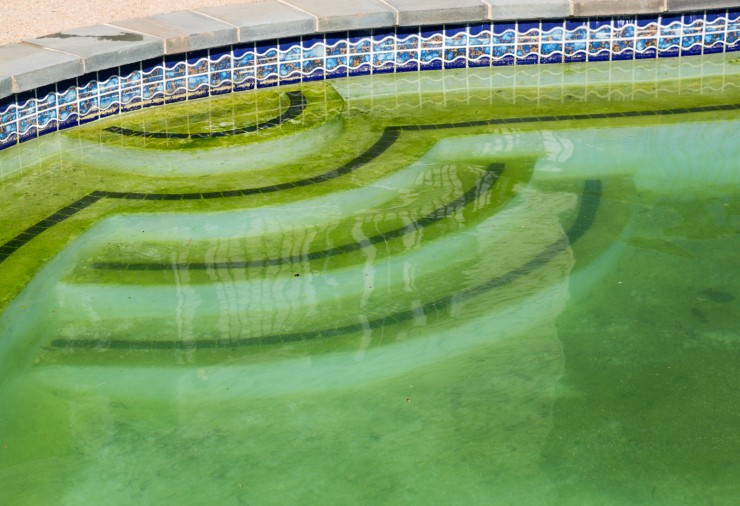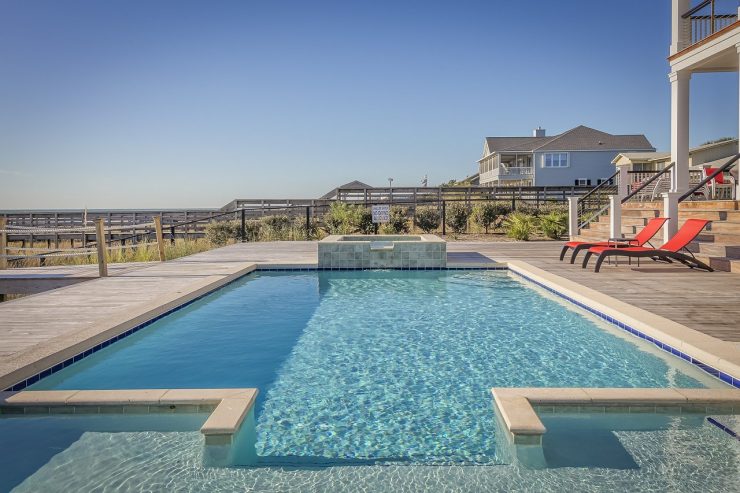
In the hot summer months, as many of us know, algae can take over a pool faster and more effectively than an out of control teenage pool party. But just because it’s now winter, don’t make the mistake of thinking the algae aren’t just waiting until you’re back’s turned in order to leap back in.
Algae might flourish best in warm water, but they’re quite content to take the rough with the smooth. So even in winter when the water temperature will make them bloom more slowly, if you give them half a chance they’re still quite capable of turning your pool into something only the Creature from the Black Lagoon would gaze at with anything approaching genuine affection.
So here are 7 ways to keep your pool clean and green algae free throughout the winter.
1. Cover Your Pool
Even if it’s warm enough in winter where you live not to warrant actually closing your pool, keeping it covered when it’s not in use is the most basic step to preventing algae growth. Not only is a pool cover a barrier to algae entering the pool, it’s also a barrier to leaves, bugs, bacteria, and dirt from entering the pool, decomposing, and providing the nourishment that helps algae to thrive.
In addition to providing nourishment for algae, leaves, bugs etc. deplete the chemical balance of your pool – crucially the chlorine level. It only takes a relatively minor drop in pool chlorine for algae to develop.
A winter pool cover made of woven solid vinyl is the most effective type of cover for keeping algae at bay. Not only do they keep organic matter and rainwater from entering the pool, they block out sunlight which algae requires in order to bloom.
Mesh winter pool covers are porous versions of the same thing. They may look neater and more attractive, and they are certainly good at keeping out large pieces of debris, but smaller silt and debris still gets through along with rainwater. And they certainly won’t keep out microscopic algae spores borne by wind and rain.
At a push, using a thermal pool blanket or even a solar pool cover will help shield your pool in winter, and is certainly better than nothing. But, because these covers are designed merely to float on the surface of the pool rather than to overlap and cover the pool sides and surrounds, they are less than ideal.
2. Keep the Pool Cover Clean
For one thing, if you keep the cover clean during the time the pool is either closed or simply not in use, it make opening it up again next season a lot less bother. More importantly, though, if you allow your pool cover – whatever type you’re using – to build up leaves and debris, it’s all too easy for the build-up to disintegrate, turn into sludge and mush, and either slide or be washed by rain water into the pool as a semi-liquid lunch for algae.
Even if you’re using a winter pool cover, allowing leaves and dirt to build up on the cover surface and mix with rain water to become a bacterial soup risks, when you try and take the cover off, having the whole lot slide into your otherwise clean pool.
So, throughout the winter, clean the leaves and debris off your cover. Also, if water starts building up on your cover, use a cover pump and maybe also a scoop net to drain the cover surface.
3. Maintain the Chemical Balance of Your Pool
As noted above, even in winter it only takes a small drop in chlorine for an unclosed pool to become party central for algae. Whether you’re using the pool or not, rain water, ground run-off water, and, if you haven’t got your pool securely covered, vegetation, bugs and beasties can still get into your pool and upset the water balance.
So check the chemical balance every 2-3 weeks and adjust it accordingly. The pH should be in a range of 7.2 to 7.6.
4. Regularly Shock Your Pool
Yes, yes, you could try telling it the one about the epileptic oyster shucker and the hooker with…but, then again, the anti-algae strategy might be better served by administering periodic doses of chlorine shock treatments. If the water temperature is between 10ᵒ and 20ᵒC, one shock every 3 weeks should be sufficient; if the water temperature is more than 21ᵒC, once every 7 -14 days.
Make sure, when you shock the pool, that you run the filter for 2-4 hours afterwards to ensure that the chemicals are evenly distributed throughout the pool.
You can read more in this article How To Shock A Swimming Pool For Beginners (In 8 Easy Steps).
Quick Note: if you’re using a solar pool cover, take it OFF the pool while you’re applying the shock treatment. The high levels of chlorine will deteriorate the cover.
5. Run the Filter Regularly
If there’s one thing that algae love almost as much as an under-chlorinated pool, it’s stagnant water. So, unless you’ve actually closed your pool, make sure to run your filter for 2 separate cycles of 1- hours each per day.
As a money saving tip, set your timer to run at night so that you can take advantage of off-peak electricity rates.
If you do happen to have an algae outbreak, you may find your filter clogs up or gets blocked quickly. If this is the case, check out our article here: Pool Filter Quickly Clogging Up (within days or hours)
6. Check You Pool on a Regular Basis
It’s all too easy to ignore the pool in winter, but if you want to make sure that uninvited algae doesn’t start taking up residence then being vigilant can save a lot of time and money later.
So, when you’re cleaning your pool cover, checking the chemical balance, or generally casting an eye over the pool to make sure that everything is in order, take a squint inside the pool to detect any early signs of possible algae growth. As we’ve already said, algae grows more slowly in winter, so it’s easier to spot the warning signs early on and take the necessary measures.
If you spot algae beginning to form, apply a shock treatment early on, and follow up a day or two later with an algaecide.
Quick Note: there are 2 different types of algaecides – some are preventatives, some are treatments. If you see algae forming in your pool, make sure you use an algaecide treatment.
7. An Ounce of Prevention
Whether you’re closing your pool or leaving it open but unused for the winter, an ounce of prevention will save a lot of heartache (and, potentially, wallet-ache) later.
Before you finally decide to abandon your pool and snuggle up on the sofa for the winter, make sure you do the following:
• Balance the Water
• Clean the Pool and Filter Thoroughly
• Shock the Pool
• Apply an algaecide preventative
Algae might party less hard in your pool in winter than they do in summer. But they can still ruin your backyard.
For a thorough discussion on preventing and dealing with algae in your pool, check out our article on Green Pool – Guide to Preventing and Removing Pool Algae
You may also refer to our article on 7 Essential Winter Maintenance Tips for a complete guide on winter pool maintenance.
Recommended Products
Related reading:
Should I Leave my Pool Cover On or Off in Winter

Related Reading: Black Algae Dangers: How To Get Rid of It From Pool

